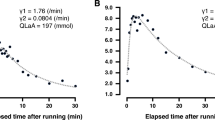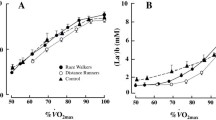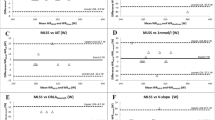Abstract
The aim of this investigation was to develop and validate a new method to predict time to exhaustion (pTE) from blood lactate variables measured during a submaximal non-exhaustive constant workload cycling test in professional cyclists. A multiple regression equation to estimate pTE from blood lactate variables measured within the first 10 min of a submaximal test and TE was determined in 40 competitive cyclists. Predicted TE reliability [individual coefficient of variation (CV)] was calculated in eight amateur cyclists who repeated the proposed test three times. Seasonal variations of pTE were monitored in 12 professional cyclists. Validity of pTE was determined by the known-group difference method in 49 professional cyclists. The prediction equation was: lognTE = 4.2067 − 0.8221(logn B) − 0.2519(logn C), where B is the lactate concentration at the 10th minute of the constant workload test and C is the lactate slope calculated between the 5th and 10th minute (adjusted r 2 =0.83, root mean square error in cross validation=23.1%). Predicted TE CV was 11.7%. The pTE obtained at the beginning of the season and the best and worst tests performed during the competitive season, resulted 162, 224 and 103% higher than the basic period test, respectively (P<0.05). Predicted TE was the only parameter discriminating elite from subelite professional cyclists. In conclusion, this study demonstrates that pTE is a valid and practical alternative to incremental tests and direct measures of endurance capacity requiring exhaustive efforts for the evaluation of competitive cyclists.




Similar content being viewed by others
References
Amann M, Subudhi AW, Walker J, Eisenman P, Shultz B, Foster C (2004) An evaluation of the predictive validity and reliability of ventilatory threshold. Med Sci Sports Exerc 36(10):1716–1722
Atkinson G, Nevill AM (1998) Statistical methods for assessing measurement error (reliability) in variables relevant to sports medicine. Sports Med 26(4):217–238
Aunola S, Alanen E, Marniemi J, Rusko H (1990) The relation between cycling time to exhaustion and anaerobic threshold. Ergonomics 33(8):1027–1042
Billat VL, Sirvent P, Py G, Koralsztein JP, Mercier J (2003) The concept of maximal lactate steady state: a bridge between biochemistry, physiology and sport science. Sports Med 33(6):407–426
Bosquet L, Leger L, Legros P (2002) Methods to determine aerobic endurance. Sports Med 32(11):675–700
Coyle EF, Feltner ME, Kautz SA, Hamilton MT, Montain SJ, Baylor AM, Abraham LD, Petrek GW (1991) Physiological and biomechanical factors associated with elite endurance cycling performance. Med Sci Sports Exerc 23(1):93–107
Faria EW, Parker DL, Faria IE (2005) The science of cycling: factors affecting performance—Part 2. Sports Med 35(4):313–337
Garcin M, Mille-Hamard L, Billat V (2004) Influence of aerobic fitness level on measured and estimated perceived exertion during exhausting runs. Int J Sports Med 25(4):270–277
Hickey MS, Costill DL, McConell GK, Widrick JJ, Tanaka H (1992) Day to day variation in time trial cycling performance. Int J Sports Med 13(6):467–470
Hinckson EA, Hopkins WG (2005) Reliability of time to exhaustion analyzed with critical-power and log-log modeling. Med Sci Sports Exerc 37(4):696–701
Hopkins WG, Hawley JA, Burke LM (1999) Design and analysis of research on sport performance enhancement. Med Sci Sports Exerc 31(3):472–485
Hopkins WG, Schabort EJ, Hawley JA (2001) Reliability of power in physical performance tests. Sports Med 31(3):211–234
Jeukendrup AE (2004) Carbohydrate intake during exercise and performance. Nutrition 20(7–8):669–677
Jeukendrup A, Saris WH, Brouns F, Kester AD (1996) A new validated endurance performance test. Med Sci Sports Exerc 28(2):266–270
Jeukendrup AE, Craig NP, Hawley JA (2000) The bioenergetics of World class cycling. J Sci Med Sport 3(4):414–433
Koutedakis Y (1995) Seasonal variation in fitness parameters in competitive athletes. Sports Med 19(6):373–392
Lucia A, Hoyos J, Perez M, Chicharro JL (2000) Heart rate and performance parameters in elite cyclists: a longitudinal study. Med Sci Sports Exerc 32(10):1777–1782
Lucia A, Hoyos J, Chicharro JL (2001) Preferred pedalling cadence in professional cycling. Med Sci Sports Exerc 33(8):1361–1366
Massart DL, Vandeginste BGM, Buydens LMC, De Jong S, Lewi PJ, Smeyers-Verbeke J (1997) Handbook of chemometrics and qualimetrics: Part A. Elsevier, Amsterdam, p. 282
McConnell AK, Romer LM (2004) Respiratory muscle training in healthy humans: resolving the controversy. Int J Sports Med 25(4):284–293
McLellan TM, Cheung SS, Jacobs I (1995) Variability of time to exhaustion during submaximal exercise. Can J Appl Physiol 20(1):39–51
Olds T (1998) The mathematics of breaking away and chasing in cycling. Eur J Appl Physiol Occup Physiol 77(6):492–497
Oyono-Enguelle S, Heitz A, Marbach J, Ott C, Gartner M, Pape A, Vollmer JC, Freund H (1990) Blood lactate during constant-load exercise at aerobic and anaerobic thresholds. Eur J Appl Physiol Occup Physiol 60(5):321–330
Paton CD, Hopkins WG (2001) Tests of cycling performance. Sports Med 31(7):489–496
Peronnet F, Thibault G (1987) Physiological analysis of running performance: revision of the hyperbolic model. J Physiol (Paris) 82(1):52–60
Pfitzinger P, Freedson PS (1998) The reliability of lactate measurements during exercise. Int J Sports Med 19(5):349–357
Sassi A, Morelli A, Impellizzeri F, Ruffini G, Mognoni P (1999) A simple prediction of the exhaustion time during submaximal cycling. In: Parisi P, Pigozzi F, Prinzi G (eds) 4th annual congress of the European College of sport science. Rome, Italy, p. 126
Schabort EJ, Hawley JA, Hopkins WG, Mujika I, Noakes TD (1998) A new reliable laboratory test of endurance performance for road cyclists. Med Sci Sports Exerc 30(12):1744–1750
Takaishi T, Yasuda Y, Ono T, Moritani T (1996) Optimal pedaling rate estimated from neuromuscular fatigue for cyclists. Med Sci Sports Exerc 28(12):1492–1497
Vautier JF, Vandewalle H, Monod H (1994) Prediction of exhaustion time from heart rate drift. Arch Int Physiol Biochim Biophys 102(1):61–65
Weltman A, Seip RL, Snead D, Weltman JY, Haskvitz EM, Evans WS, Veldhuis JD, Rogol AD (1992) Exercise training at and above the lactate threshold in previously untrained women. Int J Sports Med 13(3):257–263
Yoshida T, Suda Y, Takeuchi N (1982) Endurance training regimen based upon arterial blood lactate: effects on anaerobic threshold. Eur J Appl Physiol Occup Physiol 49(2):223–230
Acknowledgements
The authors would like to thank A. Morelli for his valuable support, plus all the cyclists involved in this study.
Author information
Authors and Affiliations
Corresponding author
Rights and permissions
About this article
Cite this article
Sassi, A., Marcora, S.M., Rampinini, E. et al. Prediction of time to exhaustion from blood lactate response during submaximal exercise in competitive cyclists. Eur J Appl Physiol 97, 174–180 (2006). https://doi.org/10.1007/s00421-006-0157-1
Accepted:
Published:
Issue Date:
DOI: https://doi.org/10.1007/s00421-006-0157-1




